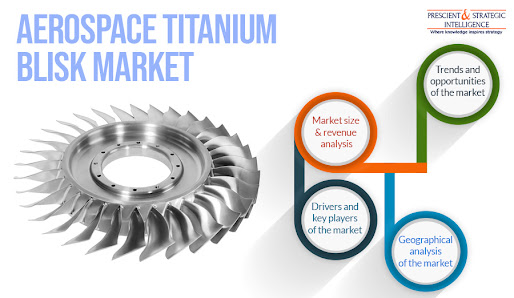Tremendous Growth Expected in Aerospace Titanium Blisk Market in Coming Years
Owing to the numerous advantages offered by titanium-based blisks, such as low weight and high strength, they are witnessing a rising demand from the aerospace sector. These components offer as much as a 50% reduction in weight, as compared to nickel- and steel-based super alloys. Moreover, titanium has a much higher strength-to-weight ratio compared to aluminum and steel, with a density of 4.5 g/cm3. The increasing demand for higher fuel efficiency is pushing the need for a high bypass ratio, which is, in turn, fuelling the adoption of low-weight blisks.
Driven by the above-mentioned factors, the revenue generated from the sales of aerospace titanium blisks increased from $3,988.3 million to $4,945.4 million, from 2017 to 2023. The global aerospace titanium blisk market is predicted to progress at a CAGR of 3.7% during the forecast period (2018–2023). Titanium blisks are used in commercial, general aviation, military and various other aerospace applications, such as in model and experimental aircraft. Amongst these, commercial aircraft recorded the highest usage of these components in 2017, owing to the rising demand for cargo and passenger air transport across the world.
Request to Get the Sample Report@ https://www.psmarketresearch.com/market-analysis/aerospace-titanium-blisk-market/report-sample
One of the biggest phenomena presently being observed in the aerospace titanium blisk market is the increasing usage of additive manufacturing techniques, in order to produce the blisks, through two distinct processes — directed energy deposition (DED) and power bed fusion (PBF). These additive manufacturing techniques help in reducing the generation of material waste and increasing the designing freedom. Moreover, these methods help in overcoming the problems and drawbacks associated with the use of computer-numerical control (CNC) machines, such as those pertaining to chipping and complexity of design.
The other major factor responsible for the rise in the demand for titanium-based aerospace blisks is the decreasing price of titanium blisks over the last few years. The price of titanium has decreased massively, more than four times from 2006 to 2017, and this has resulted in the wide-scale adoption of titanium blisks by companies operating in the aerospace sector. These blisks are used in the gas turbines or engines of aircrafts for compressing the air, for propulsion.
Geographically, North America recorded the highest utilization of aerospace titanium blisks in 2017. This is mainly ascribed to the huge demand for business air transport fleets in the region. The total business aircraft fleet size in North America was reported to be 24,297 units in 2017. The Asia-Pacific (APAC) region is expected to register the highest rise in the adoption of aerospace titanium blisks during the forecast period, due to several factors, such as the increasing fleet size of the air forces of China and India, soaring air passenger traffic, and mushrooming demand for cargo.
Make Enquiry Before Buying the Report: https://www.psmarketresearch.com/send-enquiry?enquiry-url=aerospace-titanium-blisk-market
Therefore, it is clear that the demand for aerospace titanium blisks will observe tremendous growth in future, due to the burgeoning requirement for cheaper, stronger, and lighter materials from the aerospace sector and the ballooning cargo and air travel requirements.




Comments
Post a Comment